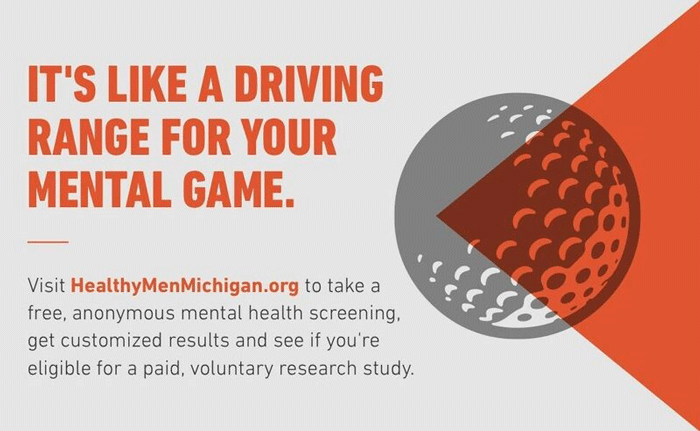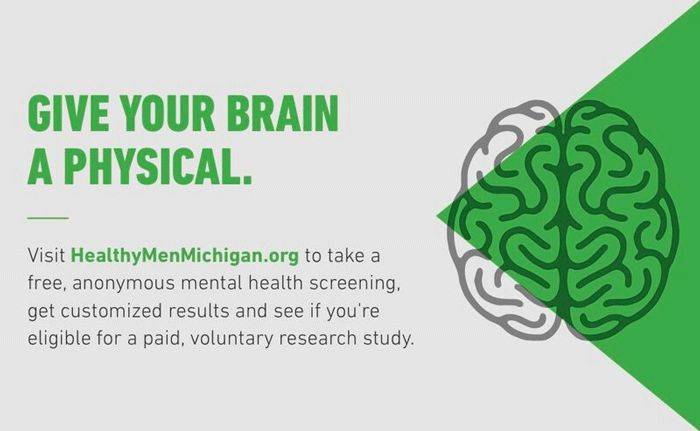Healthy Men Michigan
- Need: Mental health assessment and referral to resources for men in rural Michigan who struggle with depression and suicidal thoughts.
- Intervention: The Healthy Men Michigan campaign was a research study testing online screening for depression, including irritability and anger, and suicide risk in working-aged men. The Healthy Men Michigan campaign website also provided referrals to local and national resources specific to men's mental health and suicide prevention.
- Results: More than 5,000 individuals completed anonymous online screenings and 550 men enrolled in the study. Healthy Men Michigan secured partnerships with over 225 individual and organizational partners, including healthcare facilities, small businesses, and recreational groups across the state. Together, their efforts have helped to promote screenings, reduce stigma, and encourage help-seeking behavior to prevent suicide.
Description
In Michigan, suicide is the third leading cause of death among working-aged men ages 25-34 and fourth cause for those ages 35-44. Experts say several factors contribute to this, including men's tendencies to minimize suicide and depression warning signs. Because seeking traditional mental health services for help does not coincide with what is often the cultural definition of masculinity, many are left struggling in silence, feeling isolated and alone with their pain. Additionally, relationship problems, financial and job instability, and substance use can increase the risk of suicide among men.
Dr. Jodi J. Frey, Professor and Associate Dean for Research at the University of Maryland, Baltimore School of Social Work, took note of these statistics. In 2015, together with partners from the National Action Alliance on Suicide Prevention (NAASP)'s Workplace Task Force, Cactus, Dr. Sally Spencer Thomas, and the Colorado Office of Suicide Prevention, Dr. Frey applied for a grant from the Centers for Disease Control and Prevention (CDC) National Center for Injury Prevention to prevent suicide among working-age men in Michigan. Dr. Frey


Dr. Frey was one of two researchers funded by the CDC through this grant mechanism. With the funds and support from the project's CDC Scientific and Program Officers, the research team created and launched the Healthy Men Michigan campaign and research study.
Services offered
The Healthy Men Michigan (HMM) campaign website (no longer active) provided anonymous online screening for suicide risk with immediate feedback and referrals for additional assessment and mental health services. Men who visited the website were invited to complete an anonymous online survey, assessing suicide and depression. If they scored at risk and met the other inclusion criteria for the study, they were invited to participate in a voluntary, paid study to test online interventions, including the impact of an innovative online intervention for men called Man Therapy, to reduce suicide risk and depression among working age men (25-64 years old). Men who enrolled in the study were randomly assigned to one of two groups:
- A control group, which used the Healthy Men Michigan website (HMM; basic online depression and suicide screening with immediate results and referrals for treatment), or
- An intervention group, where men used the basic HMM website and then also used the Man Therapy website
The primary research question tested was whether use of Man Therapy in addition to HMM yielded a greater reduction in depression and suicidal ideation compared to HMM alone.
Using a public health approach to suicide prevention, the researchers established a unified statewide coalition to promote the campaign and engage men in the study by engaging both community health and mental health partners and non-health and mental health partners that come into regular contact with men. Additionally, the research team developed and expanded relationships that build on current capacity to reach working-aged men with a variety of community and industry-based partners such as:
- Male-dominated workplaces and groups in construction, rail, and emergency services
- Unions
- Media partners
- Professional sports organizations
- Veteran organizations
- Community and recreation clubs, including fitness, hunting, and boating clubs
- Faith-based organizations
- Employee Assistance Programs (EAPs)
- Fraternities and men's clubs
- Housing, unemployment, and financial services organizations
- Legal aid offices
- Barber shops
- Casinos

Healthy Men Michigan also partnered with national organizations like the American Foundation for Suicide Prevention, the National Action Alliance for Suicide Prevention, and statewide organizations such as the Michigan Department of Health and Human Services (MDHHS) to engage groups on a state and local level.
Partners throughout the state used a mix of high-tech and high-touch marketing approach in its outreach efforts, resulting in over 230 organizational partners, more than 620 Facebook followers, and nearly 400 Twitter followers. Over the course of the campaign, the research team learned what types of suicide prevention public health messages resonate stronger with working age men and the ways to use cost-effective methods to recruit working-aged men to the website. The researchers incorporated more masculine, or "manlier," messaging that resonates with men directly on Facebook, Instagram, and Twitter, and enhanced social media communications with monthly newsletters, webinars, Twitter chats, digital ads, press releases and interviews, public service announcements, public news media, and free print materials for promotional partners (e.g., posters, fliers, wallet cards).
Results
More than 4,000 men, ages 25-64 years, living in Michigan were screened. Of those who completed the initial screening, more than 50% screened at risk for suicide (ideation and/or intent), and more than 75% screened at moderate or high risk for depression. Of those men screened, over 500 enrolled in the study (N=554 final sample) and they represented men throughout Michigan when compared to U.S. Census data for age, geographic location (i.e. eight regions of the state), and other factors.
Men in both groups improved on measures of depression and suicidal ideation. Almost 80% of men in the study improved on depression over the course of the study; 36% of men moved from high risk to moderate or low risk for depression and/or lower reported rates of suicide risk between the first and third (final) survey, three months apart.
Men in the Man Therapy group reported fewer days of poor mental health, improved problem solving for social support, and increased action reaching out to others and treatment motivation. Men in the control group also reported significant improvement with fewer days of poor mental health in the last month.
Men in the Man Therapy group also improved in engaging in formal help-seeking behaviors. The researchers observed a significant difference in formal help-seeking, including using online treatment locator systems, making or attending a mental health treatment appointment, meeting with a primary care physician about mental health or attending a professionally led support group. At follow-up, men in the Man Therapy group were more likely to have used one or more of these formal help-seeking services or engage in one or more of these behaviors.
Read more about the methods and results of Man Therapy in these publications:
- Frey et al. (2022). Effectiveness of man therapy to reduce suicidal ideation and depression among working-age men: A randomized controlled trial. Suicide and Life-Threatening Behavior, 53(1), 137-153. Article Abstract
- Gilgoff J, Wagner F, Frey J, Osteen P (2022). Help-seeking and Man Therapy: The impact of an online suicide intervention. Suicide and Life-Threatening Behavior, 53(1), 154-162. Article Abstract
Dr. Frey's research continues to expand as she and her team evaluate Man Therapy with a focus on mental health improvement, help-seeking behavior and connection to Zero Suicide efforts. She is working on two projects; a CDC-funded grant with Michigan Department of Health and Human Services and another with Rhode Island's Washington County Zero Suicide Program and South County Health, funded by SAMHSA. These new projects build on what we learned from the first Man Therapy grant and build out additional partners in the states to scale our community partnerships working to prevent suicide among working-aged men.
Challenges
The team looks to expand their partnerships to evaluate Man Therapy in more states as they work to implement Man Therapy and they are working to expand into industry-specific research, such as working with construction, first responders and law enforcement, Veterans, and rural populations. Dr. Frey and the research team continue to actively seek financial support to continue their work and expand screening and support services to have a stronger focus on the intersection between substance use and misuse and suicide among working-age men, in addition to social factors such as loneliness, employment and access to mental health services.

Replication
The research team's goals for incorporating Man Therapy into a comprehensive suicide prevention package are to:
- Create social change among men and the general population about mental health and overall wellness
- Empower men to take action for their health and wellness by increasing help-seeking behavior
- Reduce suicidal thoughts and deaths among men in the long term
To achieve these goals, the research team has shared the following key lessons learned at local and national conferences and meetings:
- Start by researching existing programs and resources related to your topic so as not to duplicate information. Apply methods and resources that would meet the needs for those in your community.
- Communicate your messages appropriately to every potential partner. This is especially important when inviting organizations other than those with a mental health focus to partner. Choose information that "speaks their language," and cater your message to your audience.
- Create two-way partnerships with already-existing programs. Commit to mutual promotion of each other's initiatives. This approach will help build buy-in and sustainability as well as strengthen mental health efforts across all parties.
- Male-focused groups and businesses should be high partnership priority when trying to reach men in rural areas.
Organizations interested in learning more about how to incorporate Man Therapy into their services and programs, or how to evaluate current suicide prevention efforts using empirical methods, are encouraged to reach out to Dr. Frey.
Contact Information
Jodi Frey, PhD, Professor and Associate Dean for ResearchUniversity of Maryland, Baltimore - School of Social Work
Healthy Men Michigan
jfrey@ssw.umaryland.edu
Topics
Health screening
· Men
· Mental health
· Mental health conditions
· Networking and collaboration
· Social connectedness
· Suicide and suicide prevention
States served
Michigan
Date added
June 19, 2017
Suggested citation: Rural Health Information Hub, 2023 . Healthy Men Michigan [online]. Rural Health Information Hub. Available at: https://www.ruralhealthinfo.org/project-examples/959 [Accessed 4 January 2026]
Please contact the models and innovations contact directly for the most complete and current information about this program. Summaries of models and innovations are provided by RHIhub for your convenience. The programs described are not endorsed by RHIhub or by the Federal Office of Rural Health Policy. Each rural community should consider whether a particular project or approach is a good match for their community’s needs and capacity. While it is sometimes possible to adapt program components to match your resources, keep in mind that changes to the program design may impact results.
